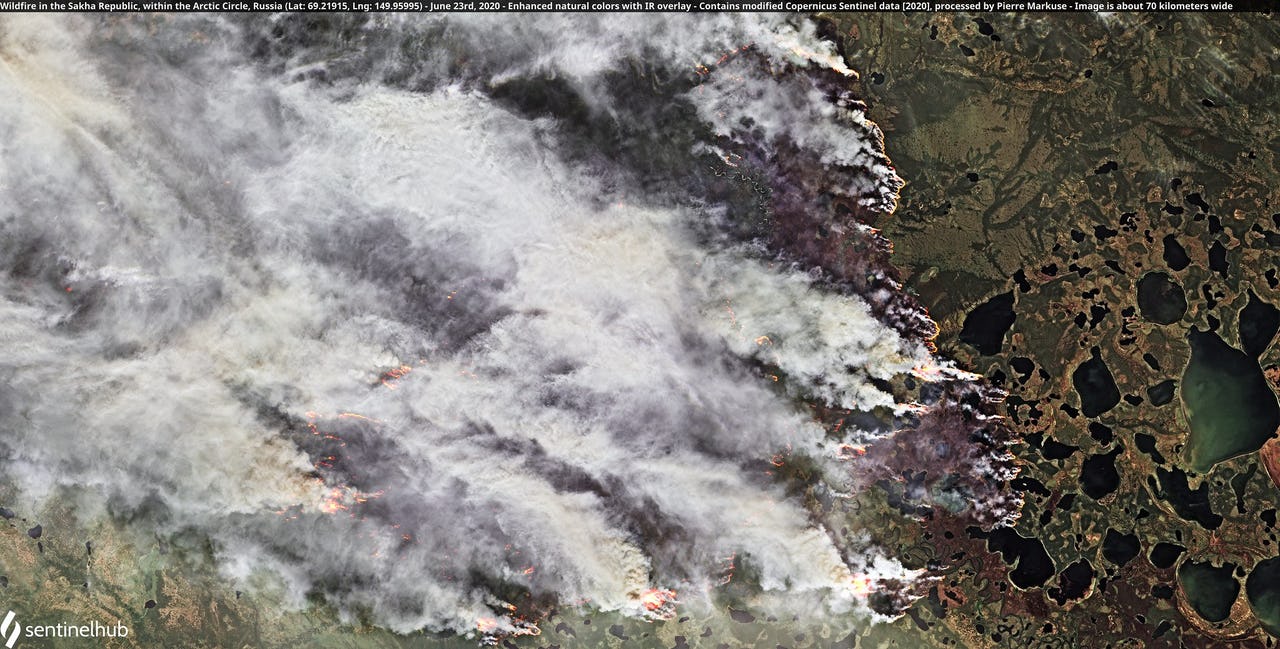Holding Hope and Grieving Loss in the New Normal of Arctic Climate Change

Wildfire in the Sakha Republic, within the Arctic Circle, Russia (Lat: 69.21915, Lng: 149.95995) – June 23rd, 2020. Photo: Pierre Markuse
When I first began studying climate change a decade ago, I was told that the front lines of those changes were in the Arctic. The region was undergoing an “unprecedented transition in human history” and experiencing some of the most dramatic impacts on the planet. And so, I became an Arctic researcher, traveling across the region to understand the depth of what stood to be lost – and advocate for equitable, courageous action to avert the worst impacts of the climate crisis.
In Alaska Native villages like Shaktoolik, Shishmaref, and Teller, I’ve witnessed how melting sea ice threatens homes, schools, and a way of life passed down from time immemorial. These communities, and along with 27 others across the state, are in imminent danger of climate displacement and need support to realize their visions of relocating to safter land. Across the Arctic in northern Russia, I’ve seen the destruction that permafrost degradation can bring as thawing ground destabilizes roads and releases billions of metric tons of carbon.
Year after year of these summer Arctic research trips, I would return to internet connection and a flurry of headlines about climate records broken. In 2018, record-breaking temperatures raced across the state of Alaska and fires burned 2.5 million acres of land, compromising public health and disrupting subsistence hunting. Last year, the Russian Arctic experienced a then record-breaking heat wave of 100.4 degrees Fahrenheit.
This summer the Arctic is on fire, again.
Extortionary blazes are now tearing through Siberia’s forests, burning 3.7 million acres, and choking cities across the region with heavy smog. These fires were made possible by a prolonged heatwave that came to a highpoint on June 20, when ground temperature in Siberia reached an unimaginable 118 degrees Fahrenheit. Throughout the northern hemisphere this summer, life-threatening temperatures overwhelmed the Arctic. Lapland, Finland has been sweltering through one of its hottest summers on record, and in Northwest Territories, Canada, temperatures rose to a record-breaking 103 degrees. While these temperatures were once extraordinary, they are now part of a life-threatening new normal. Ten years ago, the region was warming at twice the rate of the global average. Today, that number has jumped to three times as quickly. For the four million people that call the Arctic home, climate loss has been an everyday injustice for the past two decades.
But unlike my early days as a polar researcher, you no longer need to travel to the Arctic to witness the front lines of climate change. From this summer’s devastating floods in China and Germany to wildfires in western North America and eastern Russia, we are all experiencing what it means to be living in an era of extremes.
The consequences of the Arctic’s path of accelerated heating are now being felt on every continent. Extreme temperatures in the Arctic have influenced the intensity and unpredictability of weather in the mid-latitudes of our planet, exacerbating storms, droughts, heatwaves, and cold snaps. With each year of the Arctic’s record-breaking temperatures, the fatal fallout of our reliance on fossil fuels becomes more difficult to circumvent.
Last summer, I wrote that we each have a part to play in limiting the devastation of the climate crisis. I still fully believe that. We can and must demand climate action from our governments, and from ourselves, to avert the worst damage and adapt to living in a climate changed world. Every degree of warming averted matters.
Our planet is on a far better path of collective climate action in 2021 than at any other point in my lifetime. But even if we hold hope for ambitious climate action in one hand, in the other we must simultaneously cradle the painful cost of those actions coming decades past their due date. Because while Arctic residents were among the first to mourn what we cannot save in a warming world, they will not be the last.
In the years to come, climate change will exact immense grief on both a planetary and personal scale.
A recent study by insurance company Swiss Re estimates that climate change’s toll on humanity could cause the global economy to lose $23 trillion by 2050. The report argues that climate damages to physical infrastructure, crop failures, public health impacts, and redirected government spending pose “the biggest long-term risk to the global economy.”
But there’s also damage that can’t be calculated. The centuries of history destroyed each hurricane season across the Gulf Coast by wind and water. The California vineyard that once served as the backdrop for a daughter’s wedding burned beneath the raging flames of prolonged wildfire seasons. The unique taste of sourdough that’s been living on Shishmaref for 100 years displaced from its home by rising seas.
As we watch the places, traditions, and everyday routines that make us who we are disappear amid floods and fires, a zero-carbon world is no longer enough. In our new normal, we must also recognize and prepare for unavoidable climate loss. All of us today are living through a time defined by incalculable absence exacted by Covid-19. As our world begins to reckon with the devastation of this pandemic, we would do well to heed its lessons of how to document irreplaceable loss, and how to build compassion for one another amidst devastation.